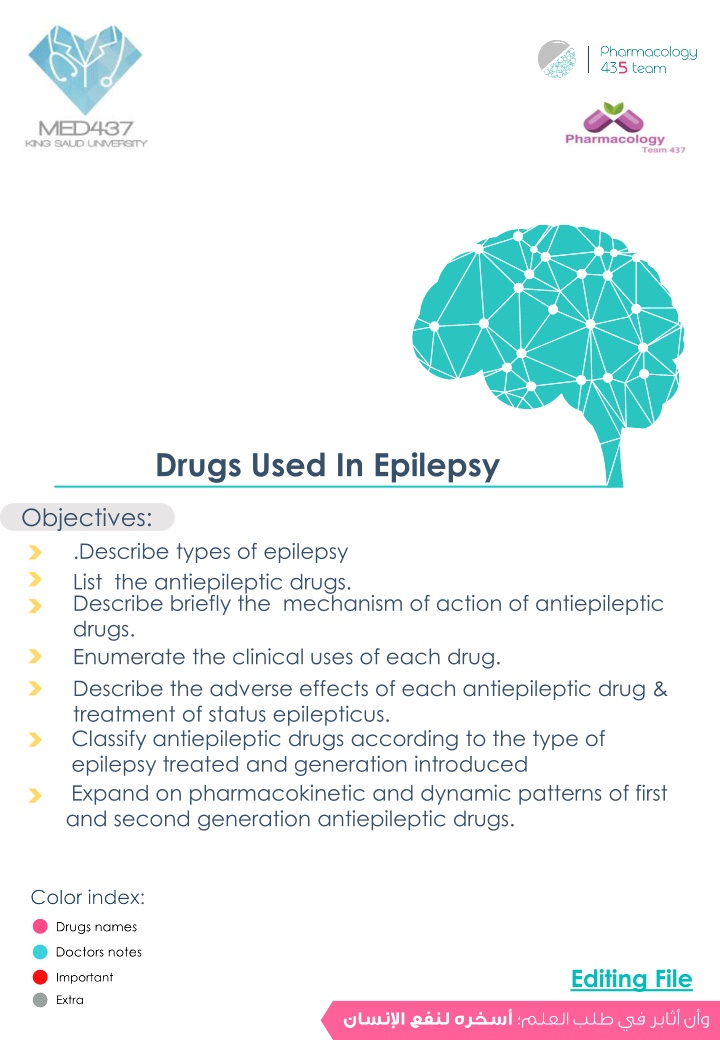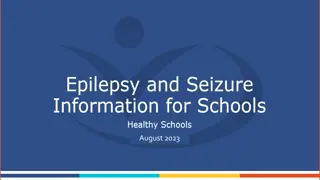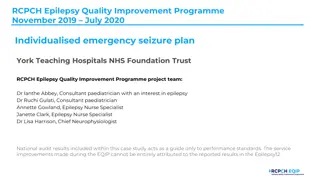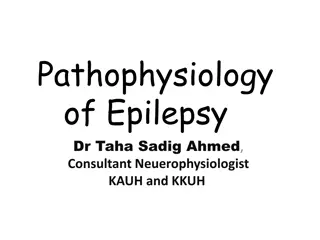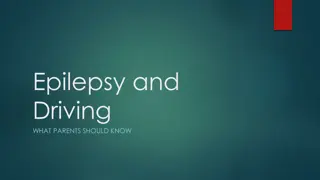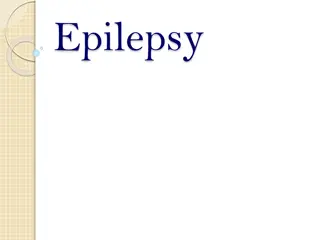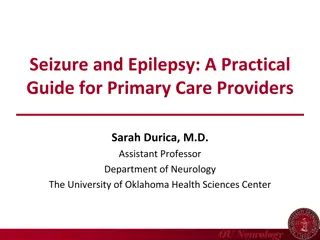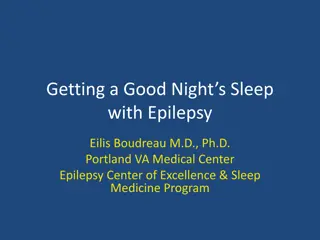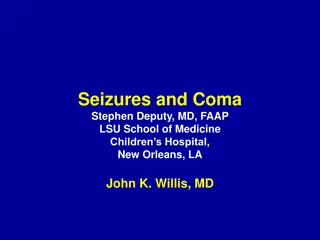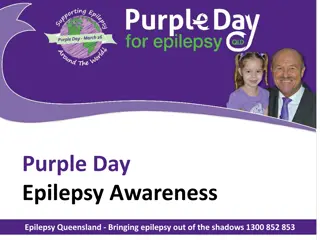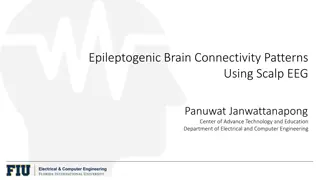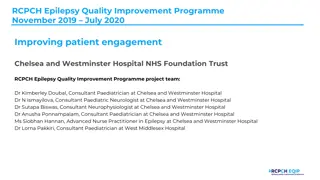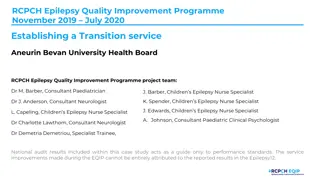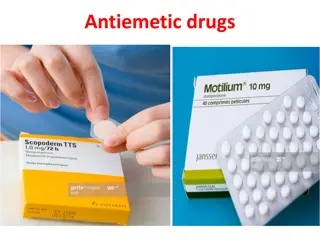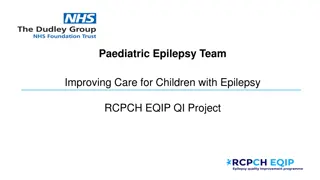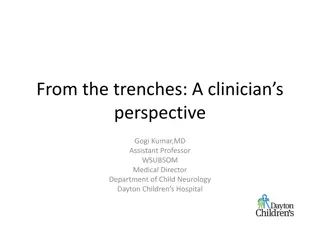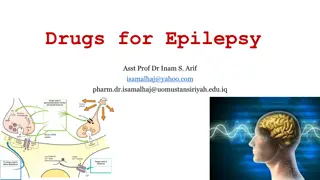Drugs Used In Epilepsy
Epilepsy is a chronic condition characterized by recurrent seizures. Learn about types of epilepsy, antiepileptic drugs, mechanisms of action, clinical uses, adverse effects, and treatment of status epilepticus. Understand the classification of antiepileptic drugs and their pharmacokinetic and dynamic patterns. Explore the triggers and classification of epilepsy, such as partial and generalized seizures.
Download Presentation

Please find below an Image/Link to download the presentation.
The content on the website is provided AS IS for your information and personal use only. It may not be sold, licensed, or shared on other websites without obtaining consent from the author.If you encounter any issues during the download, it is possible that the publisher has removed the file from their server.
You are allowed to download the files provided on this website for personal or commercial use, subject to the condition that they are used lawfully. All files are the property of their respective owners.
The content on the website is provided AS IS for your information and personal use only. It may not be sold, licensed, or shared on other websites without obtaining consent from the author.
E N D
Presentation Transcript
Drugs Used In Epilepsy Objectives: .Describe types of epilepsy List the antiepileptic drugs. Describe briefly the mechanism of action of antiepileptic drugs. Enumerate the clinical uses of each drug. Describe the adverse effects of each antiepileptic drug & treatment of status epilepticus. Classify antiepileptic drugs according to the type of epilepsy treated and generation introduced Expand on pharmacokinetic and dynamic patterns of first and second generation antiepileptic drugs. Editing File 0
Epilepsy Epilepsy is a chronic medical condition characterized by 2 or more unprovoked seizures (within 6-12 months). It is a syndrome. the difference between seizure & epileptic syndrome Seizures: are abnormal movements or behavior due to unusual electrical activity in the brain, are a symptom of epilepsy Epilepsy: is a group of related disorders characterized by a tendency for recurrent seizures :The difference between a syndrome and a disease is A syndrome is a set of medical signs and symptoms that occur together and suggest the presence of a certain disease or an increased chance of developing the disease(Usually not curable, idiopathic & combination of symptoms). A disease is the actual diagnosed impairment of health or a condition of abnormal functioning (Usually curable , non- idiopathic & it's a combination of symptoms) . Etiology(causes): Congenital defects, head injuries, trauma, hypoxia :Triggers 1 Infection ( bacteria or virus ) e.g. meningitis, brain abscess, viral encephalitis. Fatigue 2 Concussion, depressed skull, fractures. Stress 3 Brain tumors (including tuberculoma), vascular occlusion, stroke Sleep deprivation 4 Drug withdrawal, e.g. CNS depressants, alcohol or drug abuse or drug overdose ,e.g. penicillin. Poor nutrition 5 A poison, like lead 6 Alcohol Fever in children (febrile convulsion). (Februs in Latin means fever) 7 Hypoglycemia Triggers can cause an episode even under medication 8 PKU Phenylketonuria is a rare inherited disorder that causes an amino acid called phenylalanine to build up in body caused by absent or virtually absent phenylalanine hydroxylase (PAH) enzyme activity 9 Phenylalanine hydroxylase Photo epilepsy is a type of epilepsy, in which all, or almost all, seizures are triggered by flashing or flickering light Phenylalanine tyrosine 10
Classification of Epilepsy Partial (focal) Arise in one cerebral hemisphere Primary Generalized Both hemispheres + loss of consciousness. They are interconnected sometimes Tonic-clonic (Grand mal): Stiffness (15-30 sec) followed by violent contractions & relaxation (1-2 minute) Tonic: Muscle stiffness Clonic: Spasms of contraction & relaxation Atonic (loss of tone): Patients legs give under him & drop down Myoclonic: Jerking movement of the body Absence(Petit mal):Brief loss of consciousness with minor muscle twitches eye blinking In children Status epilepticus: Re-occuring tonic-clonic seizure (30 min or more)(Emergency situation may lead to death by Resp. failure) [1] Simple: consciousness is retained [2] Complex (psychomotor): Altered consciousness Secondarily generalized Begins as partial (simple or complex) and progress into tonic- clonic (grand mal) seizure. 8:49 min | very helpful! General rules for treatment of epilepsy: - Epilepsy is usually controlled but not cured with medication. - Up to 80% of pts can expect partial or complete control of seizures with appropriate treatment. 20% has resistance - Antiepileptic drugs are indicated when there is two or more seizures occurred in short interval (6 m -1y) with no cause - An initial therapeutic aim is to use only one drug (monotherapy). Drugs are usually administered orally except in status epilepsy (IV). Monitoring plasma drug level is useful Triggering factors can affect seizure control by drugs. Sudden withdrawal of drugs should be avoided. Withdrawal considered Seizure free period of 2-5 years or longer Normal IQ Normal EEG prior to withdrawal No juvenile myoclonic epilepsy (in children) Relapse rate when antiepileptics are withdrawn is 20-40%.
Treatment of Epilepsy Vagal nerve stimulation Drugs mainly Surgery Ketogenic diet Ketogenic diet may help because it will lead to accumulation of Ketones which are acidic compounds and acidosis cause neuronal suppression Mechanism of anti-epileptic :inhibit depolarization of neuron by Blockage of voltage-gated positive current (Na,Ca) Increase outward positive current (K) enhancement of inhibitory NTs (GABA) Inhibition of excitatory NTs (glutamate) Vagal nerve stimulation It is an alternative for patients who have been refractory to multiple drugs Who are sensitive to many adverse effects of antiepileptic drugs It is an expensive procedure Not very effective
Important notes Prof. Yieldez said : important to know Mechanism of action, characteristic ADRs & uses for each drug . Case: A boy was playing and suddenly he stopped,also he was staring , blinking and then he got back to normal , wath is this condition? Absence(batite) seizure. If we have to treat pregnant woman , We use the least harmful drug which is Topiramate Valproate, phenytoin & Carbamazepine are contraindicated during pregnancy.
Classification of antiepileptic drugs First generation Seconds generation Phenytoin Lamotrigine Carbamazepine Topiramate Levetiracetam Valproate Gabapentin Ethosuximide Phenobarbital & Primidone Vigabatrin Benzodiazepines (e.g. Clonazepam, lorazepam and diazepam) Felbamate Zonisamide Mnemonics: -Phenytoin: (ADRs:gingival) -Carbamazepine: carb (ADRs: hyponatremia & water intoxication) -Lamotrigine (ADRs: skin rash) ( ) -Topiramate ( ) (ADRs: weight loss) Differ from the 1stgeneration in the effect on microsomal enzymes, most of the 2ndgen drugs don t have this effect
1stGeneration Fosphenytoin Phenytoin Drug M.O.A is very important - Blockade of Na+& Ca2+influx into neuronal axon. - Inhibit the release of excitatory transmitters . - Potentiate the action of GABA. Mech. of action Parenteral form of phenytoin (IV & IM) o Given orally, well absorbed from GIT.(most drugs here are taken orally) Also available as capsule & IV Enzyme inducer. (increase its metabolism the action decreases) Metabolized by the liver to inactive metabolites. Half life approx. 20 hr. Excreted in urine. o o A Prodrug. rapidly converted to phenytoin in the body. Advantage over phenytoin: more rapid IV administration than phenytoin may be administered by IM injection Lower local tissue and cardiac toxicity than phenytoin Less pain and phlebitis at injection site than phenytoin o o o o P.K o o o o o o o Therapeutic Partial and generalized tonic-clonic seizures. Uses Not in absence seizure. In status epilepticus, given IV. Nausea or vomiting. Neurological like headache, vertigo, ataxia, diplopia , nystagmus. Sedation due to increased GABA Gum(gingival) hyperplasia. (very important) Hirsutism.(abnormal hair growth, not a good option in females ) Acne. ( ) Folic acid deficiency. (megaloblastic anemia) Vit D deficiency (osteomalacia) Teratogenic effects. (very common side effect in all antiepileptics) ADRs
1stGeneration (cont.) Carbamazepine Drug o o o o Blockade of Na+& Ca2+influx into neuronal axon. Inhibit the release of excitatory transmitters. Potentiate the action of GABA. (similar to Phenytoin in many things) MOA Available as capsule & syrup only orally. Well absorbed. Strong enzyme inducer. (including its own metabolism) Metabolized by the liver to active & inactive metabolites. T1\2=18-35 hr. Excreted in urine. o o o o o o P.K Drug of choice in partial seizures. (Both simple & complex) Tonic-clonic seizures. (1ry & 2ry generalized) Not in absence seizures. because it may cause an increase in seizures Other uses: Bipolar depression , Trigeminal neuralgia o o o uses o *carbamazepine will cause thirst >> excessive water intake >> disturbances in water-electrolytes balance >> water intoxication o o o o GIT upset. Hypersensitivity reactions. Drowsiness , ataxia, headache & diplopia. Hyponatremia & *Water intoxication. (anti-diuretic effect, and thus it should not be given to children or old patients) Teratogenicity. ADRs o Ethosuximide Drug MOA Inhibits T- type Ca2+ channels in thalamocortical neurons. o o o o o o o Absorption is complete. Syrup & capsule forms. (to be easily taken for children) Not bound to plasma proteins or tissues. Metabolized in liver. T1\2= 52-56 hr. 10-20% of a dose is excreted unchanged the urine. P.K uses Absence seizures. Mainly given to children o Gastric distress : o Nausea o vomiting Drowsiness, fatigue, hiccups, headaches. o ADRs o
1stGeneration (cont.) Sodium Valproate Drug o o o o Blocks activated Na+channels. Enhances GABA synthesis & reduces degradation. Suppress glutamate action. Blocks T-type Ca2+channels. (that s why it can be used for absence seizures) MOA o o o o o o Broad spectrum antiepileptic Available as capsules, Syrup, I.V. Metabolized by the liver. (to inactive form) Enzyme inhibitor. Inducers T1\2=12-16 hr. Excreted in urine. P.K o It is effective for all forms of epilepsy very broad spectrum o Generalized tonic-clonic seizures. (1ry& 2ry) o Absence seizures But Ethosuximide it's drug of choice in this coundiction, cause it s selective . o Complex partial seizures. o Myoclonic. o Atonic. o photosensitive epilepsy. Therapeutic Uses o o o o GI (nausea, vomiting, heart burn). Weight gain ( appetite). Transient hair loss, with re-growth of curly hair. Thrombocytopenia decreased platelet.( not used with aspirin or coumadin antiplatelet drugs ) Hepatotoxicity(Transient increase in liver enzymes). (we do periodic assessment) Teratogenicity (neural tube defect) C.I in pregnancy ADRs o o o Bipolar disorder and mania. (as a mood stabilizer) (Sodium Valproate is more favorable to treat bipolar disorder than carbamazepine) o Prophylaxis of migraine. Other uses Lennox-Gastaut syndrome. o The Lennox-Gastaut syndrome (LGS) is a type of epilepsy with multiple different types of seizures, particularly tonic (stiffening) and atonic (drop) seizures. Intellectual development is usually, but not always, impaired
2ndgeneration Dru g Topiramate Lamotrigine Blockade of Na+ channels Inhibits excitatory amino acid release (glutamate & aspartate) o Blocks Na+channels (membrane stabilization) Potentiates the inhibitory effect of GABA. o MOA o o o o o Available as oral tablets Well absorbed from GIT Metabolized primarily by glucuronidation. Does not induce or inhibit C. P-450 isozymes (most important difference from the first gen) T1\2= approx. 24 hr o o o Well absorbed orally ( 80 % ) Food has no effect on absorption Has no effect on microsomal enzymes (most important difference from the first gen) 9-17 % protein bound (minimal) Mostly excreted unchanged in urine. Plasma t 18-24 hrs o P.K o o o o As add-on therapy or as monotherapy in partial seizures & generalized tonic-clonic seizures to be more effective. Lennox-Gastaut syndrome Bipolar depression o Therapeutic Uses Can be used alone for partial, generalized tonic-clonic, and absence seizures. Lennox- Gastaut syndrome ( or lamotrigine, or valproate ). o o o o o o Psychological or cognitive dysfunction Weight loss (can be desirable side effect) Sedation Dizziness Fatigue Urolithiasis (kidney stone) Paresthesias (abnormal sensation ) Teratogenicity (in animal but not in human) Influenza-like symptoms. Skin rashes (may progress to Steven Johnson syndrome ) Somnolence (sedation) Blurred vision Diplopia Ataxia (can be teratogenic) o o o o o o o o ADRs o o o o
Treated by 1) carbamazepine 2) Phenytoin 3) valproate 4) lamotrigine Partial seizures Type of seizure Valproate or carbamazepine or phenytoin or lamotrigine Tonic-clonic (grand mal) Valproate, clonazepam Myoclonic Generalized seizures Valproate, ethosuximide Absence Atonic Valproate Drugs used for treatment of Status Epilepticus Most seizures last from few seconds to few minutes. When seizures follow one another without recovery of consciousness, it is called status epilepticus . It has a high mortality rate. Death is from cardiorespiratory failure. Antiepileptics used in status epilepticus Through IV injection of: | | | Lorazepam Diazepam Sodium Valproate Phenytoin Phenobarbital Fosphenytoin (drug of choice) Lorazepam has a shorter pharmacokinetic half-life but stays in the brain longer than diazepam.
Pregnancy & anti-epileptics Seizure is very harmful for pregnant woman. No antiepileptic drug is safe in pregnancy. Monotherapy usually better than drug combination. Valproate , phenytoin & Carbamazepine are contraindicated during pregnancy. Patient has to continue therapy. (Summary (important 1. Epilepsy is classified into partial or generalized according to the site of lesion. 2. The exact mechanism of action of AED is not known. 3. Phenytoin is mainly used for treatment of generalized tonic- clonic seizures. 4. Carbamazepine is mainly used for treatment of partial seizures. 5. Sodium valproate is a broad spectrum antiepileptic drug. 6. Lamotrigine & levetiracetam are used as monotherapy or adjunctive therapy in refractory cases. 7. Lorazepam, diazepam, phenytoin are used intravenously for treatment of status epilepticus.
Summary of 1stGeneration Drugs Drug Sodium valproate Ethosuximide Carbamazepine Phenytoin - Block influx of Ca2+and Na+ into neuronal axon potentiate the action of GABA. - Inhibit the release of excitatory transmitters. Mechanism of action - Block Na+and T type Ca2+channels - Block influx of Ca2+and Na+into neuronal axon potentiate the action of GABA - Inhibit the release of excitatory transmitters. - Enhances GABA synthesis Block T type Ca2+channels - Suppress glutamate action Fosphenytoin Parenteral form of phenytoin. 1- status epilepticus 2- partial and generalized tonic-clonic seizures Indications Partial and generalized tonic- clonic seizures Absence seizure All types of epilepsy Hair loss Hyponatremia and water intoxication 1- Folic acid & vit.D deficiency (osteomalacia) 3- teratogenic effect 4- hirsutism 5- gum hyperplasia Thrombocytopenia Hiccups ADRs Teratogenicity Gastric distress Hepatotoxicity Hypersensitivity Weight gain drowsiness Git upset teratogenicity Enzyme inducer Fosphenytoin is given I.V to treat status epilepticus its transformed rapidly into phenytoin Strong enzyme inducer Enzyme inhibitor Could be used in 1-bipolar disorder and mania 2-in migraine as prophylactic drug 3- lennox-gastaut Comments Has very long half life = 52-56 h Drug of choice in partial seizures Strong drug inducer
Summery of 2ndgeneration drugs Tobiramate Lamotrigine Drug Mechanism of action - Block Na+channels - Block Na+channels - Potentiate the inhibitory effect of GABA - Inhibit glutamate and aspartate release. Does not induce or inhibit C. P-450 isozymes o PK Has no effect on microsomal enzymes Lennux-gastaut syndrome - Urolithiasis -Influenza like syndrome - Skin rashes may progress to Steven Johnson syndrome - Somnolence (desire to sleep) - Ataxia - Paresthesia ADRs - Weight loss - Teratogenicity - Metabolized by glucuronidation - Does not induce or inhibit CP450 isoenzyme Extra info.
Questions MCQs 1 ) Which of the following drugs is an enzyme inhibitor? A-Sodium Valproate B-Carbamazepine C-Phenytoin D-Ethosuximide 2 ) Which of the following drugs is a broad spectrum antiepileptic? A-Lamotrigine B-Phenytoin C-Sodium Valproate D-Topiramate 3 ) Which drug has a minimum adverse effects? A-Carbamazepine B-Topiramate C-Lamotrigine D-Ethosuximide 4 ) Steven-Johnson syndrome is a possible adverse effect of? A-Phenytoin B-Lamotrigine C-Sodium Valproate D-Topiramate 5 ) What is the drug of choice in case of partial seizures? A-Carbamazepine B-Ethosuximide C-Lamotrigine D-Phenytoin
Questions MCQs 6 ) Which of the following drugs may cause psychological effect ? A-Topiramate B-Sodium Valproate C-Ethosuximide D-Fosphenytoin 7 ) Which drug is contraindicated in females ? A-Lamotrigine B-Carbamazepine C-Fosphenytoin D-Topiramate 8 ) Which drug is the drug of choice in case of Status Epilepticus ? A-Phenobarbital B-Benzodiazepines C-Fosphenytoin D-Valproate MCQs answers: 1-A 2-C 3-D 4-B 5-A 6-A 7-C 8-B SAQ Q1 ) a 5 years old epileptic boy came to the dentist suffering from enlargement of his gum due to antiepileptic drug. Which drug did he use ? Fosphenytoin What is the mechanism of action of this drug ? Block of Na and Ca influx potentiate the action of GABA
Team leaders: Ghaida Saad Alsanad Omar Alsuhaibani Team Members: Dimah Alaraifi Ghada Alqrni Razan Alhamidi Mohammed Nouri Special thank to Afnan Almustafa References: - Doctors slides and notes. - pharmacology Team 435. Special thank for team 435 @Pharma4370 Pharm437@gmail.com
